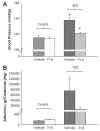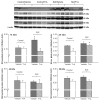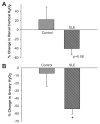Oxidative stress promotes hypertension and albuminuria during the autoimmune disease systemic lupus erythematosus
- PMID: 22291449
- PMCID: PMC3683846
- DOI: 10.1161/HYPERTENSIONAHA.111.190009
Oxidative stress promotes hypertension and albuminuria during the autoimmune disease systemic lupus erythematosus
Abstract
Several lines of evidence suggest that essential hypertension originates from an autoimmune-mediated mechanism. One consequence of chronic immune activation is the generation of oxygen-derived free radicals, resulting in oxidative stress. Renal oxidative stress has direct prohypertensive actions on renal microvascular and tubular function. Whether oxidative stress contributes to the prevalent hypertension associated with autoimmune disease is not clear. We showed previously that female NZBWF1 mice, an established model of the autoimmune disease systemic lupus erythematosus (SLE), develop hypertension associated with renal oxidative stress. In the present study we tested the hypothesis that oxidative stress contributes to autoimmune-mediated hypertension by treating SLE and control (NZW/LacJ) mice with tempol (2.0 mmol/L) and apocynin (1.5 mmol/L) in the drinking water for 4 weeks. Although the treatment did not alter SLE disease activity (assessed by plasma double-stranded DNA autoantibodies), blood pressure and renal injury (urinary albumin) were reduced in the treated SLE mice. Tempol plus apocynin-treated SLE mice had reduced expression of nitrosylated proteins in the renal cortex, as well as reduced urinary and renal cortical hydrogen peroxide, suggesting that treatment reduced renal markers of oxidative stress. These data suggest that renal oxidative stress plays an important mechanistic role in the development of autoimmune-mediated hypertension.
Figures





Comment in
-
Oxidative stress promotes hypertension and albuminuria during the autoimmune disease systemic lupus erythematosus.Hypertension. 2012 May;59(5):e47; author reply e48. doi: 10.1161/HYPERTENSIONAHA.112.193276. Epub 2012 Apr 9. Hypertension. 2012. PMID: 22493077 No abstract available.
References
-
- Ferro CJ, Edwards NC, Hutchison C, Cockwell P, Steeds RP, Savage CO, Townend JN, Harper L. Does immunosuppressant medication lower blood pressure and arterial stiffness in patients with chronic kidney disease? An observational study. Hypertens Res. 2011;34:113–119. - PubMed
-
- Herrera J, Ferrebuz A, MacGregor EG, Rodriguez-Iturbe B. Mycophenolate mofetil treatment improves hypertension in patients with psoriasis and rheumatoid arthritis. J Am Soc Nephrol. 2006;17:S218–S225. - PubMed
-
- Rodriguez-Iturbe B, Quiroz Y, Nava M, Bonet L, Chavez M, Herrera-Acosta J, Johnson RJ, Pons HA. Reduction of renal immune cell infiltration results in blood pressure control in genetically hypertensive rats. Am J Physiol Renal Physiol. 2002;282:F191–F201. - PubMed
-
- Gudbrandsson T, Hansson L, Herlitz H, Lindholm L, Nilsson LA. Immunological changes in patients with previous malignant essential hypertension. Lancet. 1981;1:406–408. - PubMed
Publication types
MeSH terms
Substances
Grants and funding
LinkOut - more resources
Full Text Sources
Other Literature Sources
Medical

